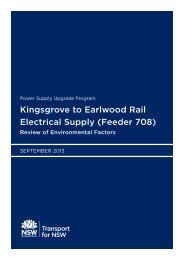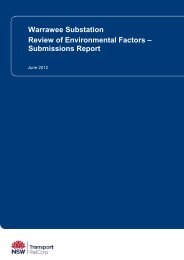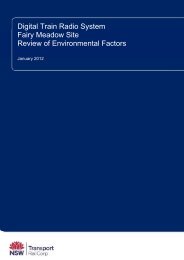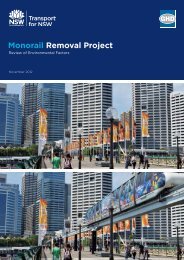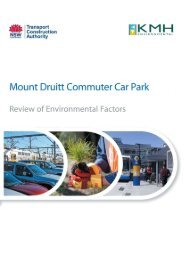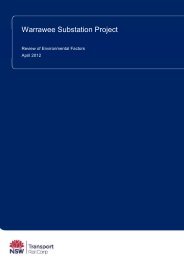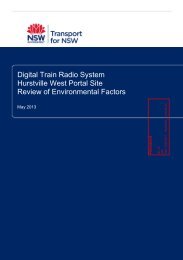Digital Train Radio System Como Site Review of Environmental ...
Digital Train Radio System Como Site Review of Environmental ...
Digital Train Radio System Como Site Review of Environmental ...
You also want an ePaper? Increase the reach of your titles
YUMPU automatically turns print PDFs into web optimized ePapers that Google loves.
• It is the only rail-specific communications standard and has the highest levels <strong>of</strong> safety<br />
and reliability in its design.<br />
• It is an open standard with a large number <strong>of</strong> equipment suppliers.<br />
• It achieved a higher level <strong>of</strong> compliance with the RailCorp functional requirements when<br />
compared to the other systems.<br />
• It is deployed by major rail operators in Europe and Asia, some with networks<br />
comparable in size and complexity to RailCorp’s network.<br />
• It operates on a spectrum <strong>of</strong> 1800 MHz which was available for purchase by RailCorp.<br />
The other options would have required the leasing <strong>of</strong> a radio spectrum from a<br />
telecommunications licence holder.<br />
• It is a scalable network that can grow in step with RailCorp operations and network.<br />
• It is compatible with the Australian Rail Track Corporation’s communication system.<br />
• It provides a platform for future enhancements and increased operational safety,<br />
including a Level 2 Automatic <strong>Train</strong> Protection (ATP) <strong>System</strong>, as per the<br />
recommendations <strong>of</strong> the Waterfall inquiry.<br />
• It will deliver the best value for money solution with the least risk.<br />
3.5 Alternatives to the <strong>Como</strong> site<br />
The following options were considered for the development <strong>of</strong> the <strong>Como</strong> site:<br />
• to do nothing;<br />
• install the antennas on existing communication facilities in the <strong>Como</strong> area; or<br />
• Install a new BTS within the rail corridor near <strong>Como</strong> Station.<br />
The do nothing option was rejected for the reasons listed below.<br />
• The inability to meet the requirement <strong>of</strong> 100% network coverage.<br />
• A ‘black spot’ in the DTRS network, resulting in a significant safety issue in the event <strong>of</strong> an<br />
emergency call or a train incident.<br />
• The increasing maintenance costs <strong>of</strong> the MetroNet facility and the limited reliability for<br />
adequate operation for the next 10 – 15 years.<br />
None <strong>of</strong> the existing communications facilities were in a suitable position or <strong>of</strong>fered the required<br />
height to provide adequate coverage to the rail network, and so were not selected for this<br />
proposal.<br />
<strong>Radio</strong> frequency modelling also indicated that a new BTS at <strong>Como</strong> railway station would not<br />
provide adequate coverage to the rail corridor. A second site would then be required, increasing<br />
the costs and environmental risks <strong>of</strong> the proposal.



